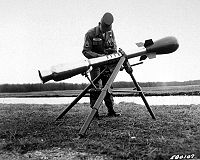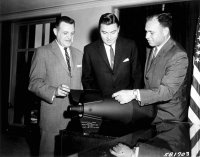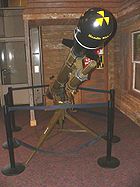
Davy Crockett (nuclear device)
Encyclopedia

Tactical nuclear weapon
A tactical nuclear weapon refers to a nuclear weapon which is designed to be used on a battlefield in military situations. This is as opposed to strategic nuclear weapons which are designed to menace large populations, to damage the enemy's ability to wage war, or for general deterrence...
recoilless gun for firing the M388 nuclear projectile that was deployed by the United States
United States
The United States of America is a federal constitutional republic comprising fifty states and a federal district...
during the Cold War
Cold War
The Cold War was the continuing state from roughly 1946 to 1991 of political conflict, military tension, proxy wars, and economic competition between the Communist World—primarily the Soviet Union and its satellite states and allies—and the powers of the Western world, primarily the United States...
. Named after American soldier
Soldier
A soldier is a member of the land component of national armed forces; whereas a soldier hired for service in a foreign army would be termed a mercenary...
, congress
United States Congress
The United States Congress is the bicameral legislature of the federal government of the United States, consisting of the Senate and the House of Representatives. The Congress meets in the United States Capitol in Washington, D.C....
man, and folk hero
Folk hero
A folk hero is a type of hero, real, fictional, or mythological. The single salient characteristic which makes a character a folk hero is the imprinting of the name, personality and deeds of the character in the popular consciousness. This presence in the popular consciousness is evidenced by...
Davy Crockett
Davy Crockett
David "Davy" Crockett was a celebrated 19th century American folk hero, frontiersman, soldier and politician. He is commonly referred to in popular culture by the epithet "King of the Wild Frontier". He represented Tennessee in the U.S...
, it was one of the smallest nuclear weapon systems ever built.
Development

Soviet Union
The Soviet Union , officially the Union of Soviet Socialist Republics , was a constitutionally socialist state that existed in Eurasia between 1922 and 1991....
troops had war broken out in Europe. Small teams of the Atomic Battle Group (charged with operating the device) would be stationed every few kilometers to guard against Soviet attack, using the power of their nuclear artillery
Nuclear artillery
Nuclear artillery is a subset of limited-yield tactical nuclear weapons, in particular those weapons that are launched from the ground at battlefield targets...
to kill or incapacitate advancing troop formations and irradiate the area so that it was uninhabitable for up to 48 hours, long enough to mobilize NATO forces.
The M-388 round used a version of the W54
W54
The W54 was the smallest nuclear warhead deployed by the United States. It was a very compact implosion-type nuclear weapon design, designed for tactical use and had a very low yield for a nuclear weapon.- Development :...
warhead
Warhead
The term warhead refers to the explosive material and detonator that is delivered by a missile, rocket, or torpedo.- Etymology :During the early development of naval torpedoes, they could be equipped with an inert payload that was intended for use during training, test firing and exercises. This...
, a very small sub-kiloton fission
Nuclear fission
In nuclear physics and nuclear chemistry, nuclear fission is a nuclear reaction in which the nucleus of an atom splits into smaller parts , often producing free neutrons and photons , and releasing a tremendous amount of energy...
device. The Mk-54 weighed about 51 lb (23 kg), with a yield equivalent to somewhere between 10 or 20 tons of TNT (very close to the minimum practical size and yield for a fission warhead). The only selectable feature with either versions of the Davy Crockett (M28 & M29) was the height of burst dial on the warhead (post-Davy Crockett versions of the W54 nuclear device apparently had a selectable yield feature). {See new External Links below for Hi/Lo Switch and Launching Piston references] The complete round weighed 76 lb (34.5 kg). It was 31 in. (78.7 cm) long with a diameter of 11 in. (28 cm) at its widest point; a subcaliber piston at the back of the shell was inserted into the launcher's barrel for firing. The "piston" was considered a spigot prior to the discharge of the propellant cartridge in the recoilless gun chamber of the Davy Crockett. The M388 atomic projectile was mounted on the barrel-inserted spigot via bayonet slots. Once the propellant was discharged the spigot became the launching piston for the M388 atomic projectile. The nuclear yield is hinted at in FM 9-11: Operation and Employment of the Davy Crockett Battlefield Missile, XM-28/29 (June 1963).
The M-388 could be launched from either of two launchers known as the Davy Crockett Weapon System(s): the 4-inch (120 mm) M28, with a range of about 1.25 mi (2 km), or the 6.1-in (155 mm) M29, with a range of 2.5 mi (4 km). Both weapons used the same projectile, and were either mounted on a tripod launcher transported by an armored personnel carrier, or they were carried by a Jeep (M-38 & later M-151). The Jeep was equipped with an attached launcher for the M28 or the M29, as required, whereas the Davy Crockett carried by an armored personnel carrier was set up in the field on a tripod away from the carrier. The Davy Crocketts were operated by a three-man crew. In the 3rd Armored Division in Germany in the 1960s many Davy Crockett Sections (all of which were in the Heavy Mortar Platoons, in Headquarters Companies of Infantry or Armor Maneuver Battalions) received what became a mix of M28 & M29 launchers [e.g., one of each per D/C section]. Eventually, the M28's were replaced by M29's, so that both the armored personnel carriers and the Jeeps carried the M29.

Radiation
In physics, radiation is a process in which energetic particles or energetic waves travel through a medium or space. There are two distinct types of radiation; ionizing and non-ionizing...
hazard. The M-388 would produce an almost instantly lethal radiation dosage (in excess of 10,000 rem
Röntgen equivalent man
Named after Wilhelm Röntgen , the roentgen equivalent in man or rem is a unit of radiation dose equivalent...
) within 500 feet (150 m), and a probably fatal dose (around 600 rem) within a quarter mile (400 m).
The warhead was tested on July 7, 1962 in the Little Feller II weapons effects test shot, and again in an actual firing of the Davy Crockett from a distance of 1.7 miles (2.72 km) in the Little Feller I test shot on July 17. This was the last atmospheric test detonation at the Nevada Test Site
Nevada Test Site
The Nevada National Security Site , previously the Nevada Test Site , is a United States Department of Energy reservation located in southeastern Nye County, Nevada, about northwest of the city of Las Vegas...
.
Production of the Davy Crockett began in 1956, with a total of 2,100 being made. The weapon was tested between 1962 and 1968 at the Pohakuloa Training Area
Pohakuloa Training Area
Pōhakuloa Training Area is located on the island of Hawaii in the high plateau between Mauna Loa, Mauna Kea and the Hualālai volcanic mountains...
on Hawaii island
Hawaii (island)
The Island of Hawaii, also called the Big Island or Hawaii Island , is a volcanic island in the North Pacific Ocean...
, with 714 M101 spotter rounds (not live warheads) that contained depleted uranium
Depleted uranium
Depleted uranium is uranium with a lower content of the fissile isotope U-235 than natural uranium . Uses of DU take advantage of its very high density of 19.1 g/cm3...
.
The weapon was deployed with U.S. Army forces from 1961 to 1971. It was inactivated from US Army Europe (in West Germany) in 1967.
Versions of the W54 warhead were also used in the Special Atomic Demolition Munition
Special Atomic Demolition Munition
The Special Atomic Demolition Munition was a family of man-portable nuclear weapons fielded by the US military in the 1960s, but never used in actual combat. The US Army planned to use the weapons in Europe in the event of a Soviet invasion...
project and the AIM-26A Falcon
AIM-26 Falcon
The AIM-26 Falcon was a larger, more powerful version of the AIM-4 Falcon air-to-air missile built by Hughes. It is the only guided U.S. air-to-air weapon with a nuclear warhead, though the unguided AIR-2 Genie was also nuclear-armed.-Development:...
.
The 55th and 56th Infantry Platoons, attached to the Division Artillery of the US 82nd Airborne Division, were the last units equipped with the M-29 Davy Crockett weapons system. These two units were parachute deployed and, with a 1/2 ton truck per section, (3 per platoon) were fully air droppable. The units were deactivated in mid-1968.
Location
Below is a list of museums which have a Davy Crockett casing in their collection:- Air Force Space & Missile MuseumAir Force Space & Missile MuseumThe Air Force Space & Missile Museum is located at Launch Complex 26 at Cape Canaveral Air Force Station, Florida. It includes artifacts from the early American space program and includes an outdoor rocket garden displaying rockets, missiles and space-related equipment chronicling the US Air...
, Cape Canaveral Air Force StationCape Canaveral Air Force StationCape Canaveral Air Force Station is an installation of the United States Air Force Space Command's 45th Space Wing, headquartered at nearby Patrick Air Force Base. Located on Cape Canaveral in the state of Florida, CCAFS is the primary launch head of America's Eastern Range with four launch pads...
, FloridaFloridaFlorida is a state in the southeastern United States, located on the nation's Atlantic and Gulf coasts. It is bordered to the west by the Gulf of Mexico, to the north by Alabama and Georgia and to the east by the Atlantic Ocean. With a population of 18,801,310 as measured by the 2010 census, it... - National Atomic MuseumNational Atomic MuseumThe National Museum of Nuclear Science & History is a national repository of nuclear science information chartered by the 102nd United States Congress under Public Law 102-190, and located in Albuquerque, New Mexico. "The mission of the National Atomic Museum is to serve as America's resource for...
, Albuquerque, New MexicoAlbuquerque, New MexicoAlbuquerque is the largest city in the state of New Mexico, United States. It is the county seat of Bernalillo County and is situated in the central part of the state, straddling the Rio Grande. The city population was 545,852 as of the 2010 Census and ranks as the 32nd-largest city in the U.S. As... - National Infantry MuseumNational Infantry MuseumThe National Infantry Museum is a museum located in South Columbus, Georgia, just outside Fort Benning, the home of the Infantry. The museum honors the history of infantry forces in the United States Army.The museum is in size and cost $107 million to build...
, Fort BenningFort BenningFort Benning is a United States Army post located southeast of the city of Columbus in Muscogee and Chattahoochee counties in Georgia and Russell County, Alabama...
, GeorgiaGeorgia (U.S. state)Georgia is a state located in the southeastern United States. It was established in 1732, the last of the original Thirteen Colonies. The state is named after King George II of Great Britain. Georgia was the fourth state to ratify the United States Constitution, on January 2, 1788... - United States Army Ordnance MuseumUnited States Army Ordnance MuseumThe U.S. Army Ordnance Museum is a museum that is in the process of being re-located to Fort Lee, in Fort Lee, Virginia. Its previous building—at Aberdeen Proving Ground in Aberdeen, Maryland—was closed in September 2010, although many outdoor exhibits are still accessible to the...
, Aberdeen Proving GroundAberdeen Proving GroundAberdeen Proving Ground is a United States Army facility located near Aberdeen, Maryland, . Part of the facility is a census-designated place , which had a population of 3,116 at the 2000 census.- History :...
, MarylandMarylandMaryland is a U.S. state located in the Mid Atlantic region of the United States, bordering Virginia, West Virginia, and the District of Columbia to its south and west; Pennsylvania to its north; and Delaware to its east... - Watervliet Arsenal MuseumIron Building (Watervliet Arsenal)The Iron Building is a historic building at the Watervliet Arsenal in Watervliet, New York. It currently serves as the Watervliet Arsenal Museum....
, Watervliet, New YorkWatervliet, New YorkWatervliet is a city in Albany County in the US state of New York. The population was 10,254 as of the 2010 census. Watervliet is north of Albany, the capital of the state, and is bordered on the north, west, and south by the town of Colonie. The city is also known as "the Arsenal City".- History... - West Point Museum, West Point, New YorkWest Point, New YorkWest Point is a federal military reservation established by President of the United States Thomas Jefferson in 1802. It is a census-designated place located in Town of Highlands in Orange County, New York, United States. The population was 7,138 at the 2000 census...
- Atomic Testing MuseumAtomic Testing MuseumThe Atomic Testing Museum in Las Vegas, Nevada, documents the history of nuclear testing at the Nevada Test Site in the desert north of Las Vegas.-Founding:The museum opened in March 2005...
, Las Vegas, NevadaLas Vegas, NevadaLas Vegas is the most populous city in the U.S. state of Nevada and is also the county seat of Clark County, Nevada. Las Vegas is an internationally renowned major resort city for gambling, shopping, and fine dining. The city bills itself as The Entertainment Capital of the World, and is famous... - Don F. Pratt Museum, Fort CampbellFort CampbellFort Campbell is a United States Army installation located astraddle the Kentucky-Tennessee border between Hopkinsville, Kentucky, and Clarksville, Tennessee...
, Clarksville, TennesseeClarksville, TennesseeClarksville is a city in and the county seat of Montgomery County, Tennessee, United States, and the fifth largest city in the state. The population was 132,929 in 2010 United States Census...
See also
- Nuclear weaponNuclear weaponA nuclear weapon is an explosive device that derives its destructive force from nuclear reactions, either fission or a combination of fission and fusion. Both reactions release vast quantities of energy from relatively small amounts of matter. The first fission bomb test released the same amount...
- Nuclear artilleryNuclear artilleryNuclear artillery is a subset of limited-yield tactical nuclear weapons, in particular those weapons that are launched from the ground at battlefield targets...
- Nuclear weapon designNuclear weapon designNuclear weapon designs are physical, chemical, and engineering arrangements that cause the physics package of a nuclear weapon to detonate. There are three basic design types...
- Nuclear strategyNuclear strategyNuclear strategy involves the development of doctrines and strategies for the production and use of nuclear weapons.As a sub-branch of military strategy, nuclear strategy attempts to match nuclear weapons as means to political ends...
External links
- Facts about the "Davy Crockett" missile
- Loaded and unloaded M29 Davy Crockett
- Hi and Lo Height of Burst Switch
- D/C Launching Piston
- Characteristics of all US nuclear weapons designs
- DCs in 3rd Armored Division
- DCs on the highway
- President Kennedy questions Davy Crockett crewmen
- DC Souvenirs
- See John Marshall's Davy Crockett write up in the 3rd Bn, 36th Infantry section
- Davy Crocketts in Southern Avenue of Fulda Gap
- Davy Crocketts during Oct 62 Cuban Crisis (Southern Avenue of Fulda Gap)-- see especially bottom of jchorazy's Page 12
- Video showing testing of device on youtube.com
- Operation Ivy Flats — testing of the Davy Crockett, 1962 (17:46)
- Wee Gwen - a UK weapon similar to Davy Crockett

